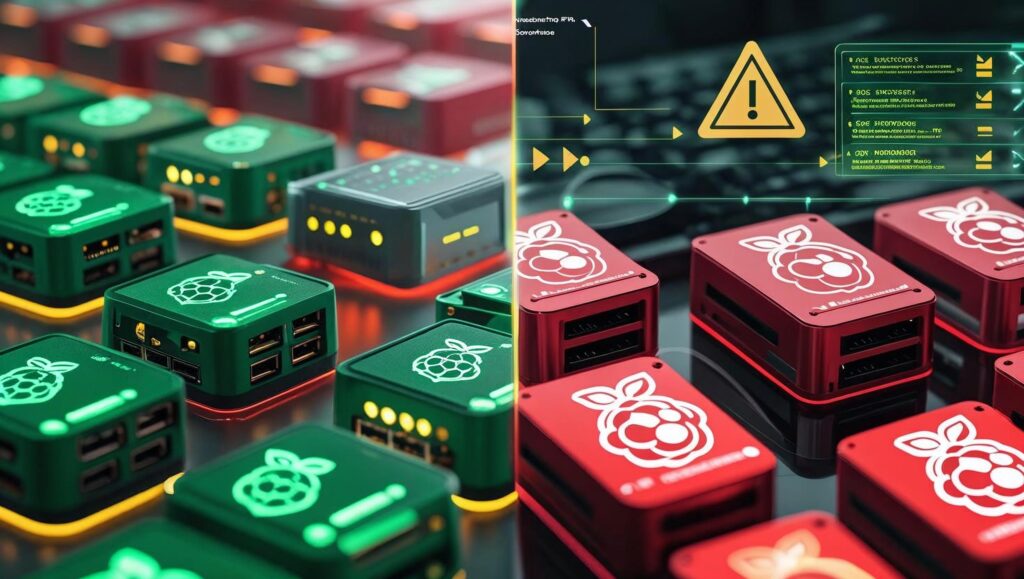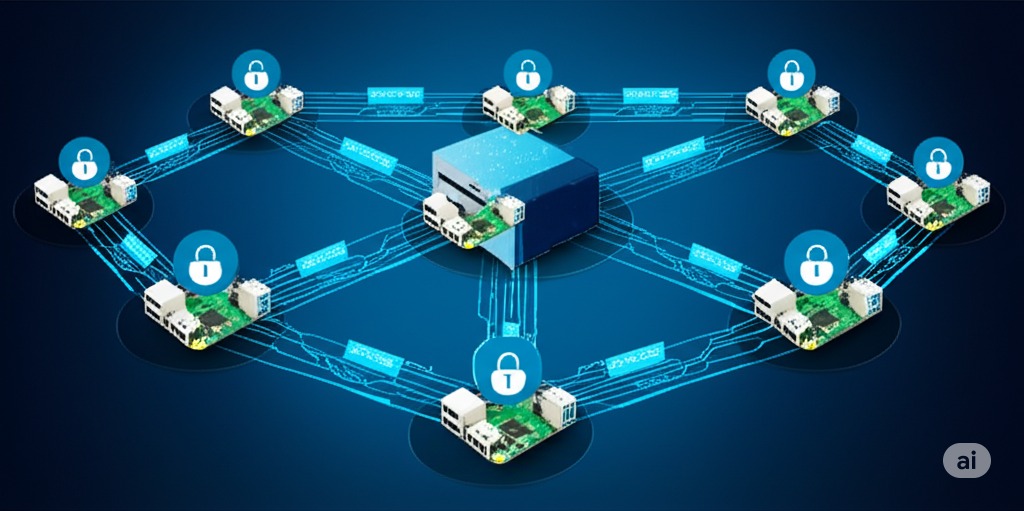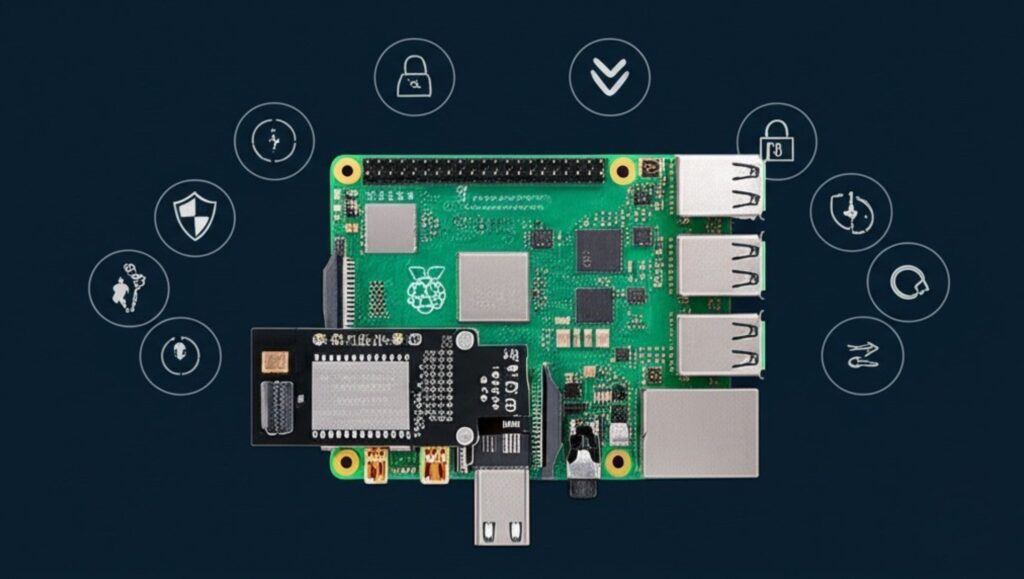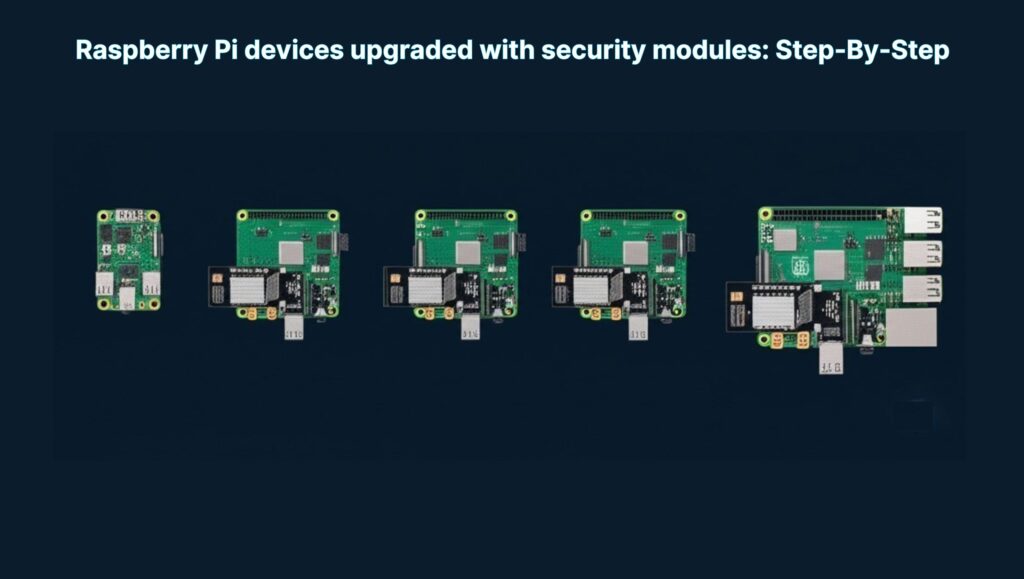TL;DR: You’ll prevent 3 AM crisis calls when your Raspberry Pi fleet fails—hardware-anchored security and automated recovery transform 50 vulnerable devices into resilient operations.
Raspberry Pi Fleet Management: What Can Go Wrong?
Managing a single Raspberry Pi is straightforward. However, scaling to dozens of devices introduces complex challenges that can cripple operations if not properly addressed.
Effective Raspberry Pi fleet management requires a comprehensive approach to security, automated recovery, and long-term reliability. This approach need to go far beyond individual device setup.
This guide explores the critical risks facing distributed Pi deployments. It demonstrates how integrated hardware and software solutions can transform reactive troubleshooting into proactive fleet resilience.
This post is sponsored by Zymbit.
Key Takeaways
- Fleet-scale Raspberry Pi deployments face exponential complexity compared to single-device projects, requiring specialized management approaches
- Update failures, security vulnerabilities, and hardware degradation create cascading risks that can compromise entire fleet operations
- Hardware-anchored security provides the foundation for scalable fleet management, preventing software-only vulnerabilities
- Integrated solutions like Zymbit’s Bootware enable autonomous recovery and secure updates across distributed Pi deployments
- Proactive resilience measures dramatically reduce operational overhead while improving Raspberry Pi fleet reliability and security posture
The 3 AM Fleet Failure: When Pi Deployments Go Wrong

Picture this: Sarah, an engineering manager at a smart building company, receives urgent alerts at 3 AM. Thirty percent of their deployed Raspberry Pi sensors have failed to boot after a routine firmware update.
What started as a simple overnight maintenance window has become a crisis affecting multiple client locations across the city.
This scenario isn’t hypothetical—it’s a reality many organizations face when scaling deployments without proper Raspberry Pi fleet management infrastructure. The devices that worked flawlessly during development and small-scale testing suddenly become operational liabilities when deployed at scale.
The cascading failure Sarah experienced highlights a fundamental truth: managing dozens of edge devices requires fundamentally different approaches than managing individual units. Without proper safeguards, a single failed update can propagate across an entire fleet, creating widespread outages that are expensive and time-consuming to resolve.
What Makes Distributed IoT Device Management So Complex?

The transition from managing a handful of Raspberry Pi devices to orchestrating dozens reveals hidden complexity that catches many teams unprepared. What works seamlessly for five devices often breaks down catastrophically at fifty, creating operational challenges that traditional IT management approaches aren’t designed to handle.
Unlike centralized servers in controlled environments, edge device fleets operate in unpredictable conditions with intermittent connectivity, varying power quality, and limited physical access. Each device must function autonomously while remaining part of a coordinated system—a balance that requires sophisticated coordination between security, update mechanisms, and recovery systems.
The mathematical reality of Raspberry Pi fleet management compounds these challenges. With a single device, you have one potential failure point. With fifty devices, you have fifty individual failure points plus the complex interactions between them.
Traditional troubleshooting approaches that rely on manual intervention quickly become unsustainable when multiplied across distributed deployments.
Why Do Raspberry Pi Fleets Face Critical Lifecycle Risks?

Update failures represent the most immediate and widespread threat to Raspberry Pi fleet stability. Unlike traditional computers with robust recovery mechanisms, standard Pi deployments often lack fail-safe update processes, making them vulnerable to complete system failures during routine maintenance.
The cascading nature of update failures creates particularly dangerous scenarios. When multiple devices attempt to download and install updates simultaneously, network congestion can cause partial downloads or corrupted installations. Without proper verification and rollback mechanisms, these corrupted updates can render devices completely inoperable—a condition known as “bricking.”
Power interruptions during updates compound this risk exponentially. Industrial and IoT environments often experience unstable power conditions, and an update interrupted by power loss can corrupt critical system files. In Raspberry Pi fleet deployments, this same power event might affect multiple devices simultaneously, creating widespread outages that require physical intervention at each location.
What Security Vulnerabilities Multiply at Fleet Scale?
Security vulnerabilities that seem manageable in small deployments become critical risks when multiplied across fleet-scale operations. Physical access threats, credential management challenges, and the lack of hardware-based security create attack surfaces that grow exponentially with fleet size.
Physical tampering becomes a significant concern when devices are distributed across multiple, often unsecured locations. As detailed in our comprehensive guide to Raspberry Pi physical security, unprotected devices allow attackers to easily extract sensitive data, modify firmware, or install malicious code by simply removing the SD card.
The challenge of maintaining consistent security policies across distributed devices creates additional vulnerabilities. Without centralized, hardware-anchored security management, ensuring that all devices maintain proper encryption, authentication, and access controls becomes an operational nightmare that often leads to security compromises.
How Does Hardware Degradation Impact Raspberry Pi Fleet Reliability?
Hardware degradation affects fleet deployments differently than individual devices, creating reliability patterns that can be difficult to predict and manage. SD card failures, power supply degradation, and environmental factors accumulate over time, creating maintenance burdens that can overwhelm operational teams.
SD card corruption represents one of the most common failure modes in Raspberry Pi deployments. The flash memory used in most SD cards has limited write cycles, and log files, temporary data, and frequent updates can quickly exhaust this capacity. In fleet deployments, cards from the same manufacturing batch often fail around the same time, creating clustered outages that strain support resources.
Environmental factors like temperature fluctuations, humidity, and power quality variations affect hardware longevity in ways that are difficult to predict. These factors often correlate geographically, meaning devices in similar locations may experience similar degradation patterns, leading to simultaneous failures that can overwhelm maintenance capabilities.
Why Traditional IT Management Systems Fail for Edge Computing?

Enterprise device management tools, designed for controlled data center environments, fundamentally misunderstand the requirements of edge device fleets. These systems assume reliable network connectivity, predictable power conditions, and physical accessibility—assumptions that rarely hold true for distributed Raspberry Pi deployments.
The intermittent connectivity common in edge environments breaks traditional management paradigms. Centralized management systems expect continuous communication with managed devices, but edge deployments often operate with periodic connectivity or during specific maintenance windows. This disconnect creates blind spots where device status becomes unknown, making proactive management impossible.
Physical accessibility limitations compound these challenges significantly. While data center equipment can be quickly accessed for maintenance or troubleshooting, edge devices might be located in remote facilities, locked enclosures, or environmentally challenging locations. Management systems that rely on physical intervention for recovery don’t scale to edge deployments where site visits are expensive and time-consuming.
How Does Hardware Root of Trust Enable Scalable IoT Security?

Hardware root of trust provides the foundational security layer that makes scalable fleet management possible. Unlike software-based security measures that can be compromised or bypassed, hardware security modules create isolated security boundaries that remain effective even when the main system is compromised.
The concept of hardware-anchored security becomes critical at fleet scale because it eliminates many of the vulnerabilities that multiply across distributed deployments. When cryptographic keys and security operations are isolated in dedicated hardware, the attack surface doesn’t scale linearly with the number of devices—each device maintains its security boundary independently.
Hardware security modules enable scalable Raspberry Pi fleet management by providing consistent security primitives across all devices. Rather than managing complex software configurations that can drift over time, hardware-anchored security ensures that fundamental security operations remain consistent and verifiable across the entire fleet, dramatically simplifying security policy enforcement and audit processes.
How Does Secure Boot Prevent Fleet-Wide System Compromises?

Secure boot mechanisms create a verified chain of trust that prevents compromised software from executing across fleet deployments. This becomes particularly critical in distributed environments where detecting and responding to security compromises can take days or weeks rather than hours.
The A/B partitioning approach used in Resilient Boot implementations provides fail-safe update mechanisms that prevent the cascade failures common in traditional Pi deployments. Resilient Boot creates a self-healing system architecture where devices maintain two complete system images and only switch to updated versions after successful verification. This resilient approach ensures devices can autonomously recover from failed updates without requiring physical intervention, building recovery capabilities directly into the boot process itself.
Automatic rollback capabilities transform update failures from fleet-wide crises into manageable maintenance events. When an update fails verification or causes system instability, secure boot mechanisms can automatically revert to the previous known-good configuration, maintaining device availability while providing diagnostic information for addressing the underlying issue.
What Challenges Does Encrypted Storage Present at Fleet Scale?

Managing encrypted storage across dozens of devices introduces key management complexities that don’t exist in single-device deployments. Centralized key management systems must balance security with operational efficiency, ensuring that keys remain protected while enabling legitimate administrative access across the fleet.
Key rotation presents particular challenges in fleet environments where devices may have limited connectivity windows. Traditional key rotation approaches that require real-time communication become impractical when devices operate in intermittent connectivity environments or have scheduled maintenance windows.
Hardware-based key storage solves many fleet-scale encryption challenges by providing consistent, tamper-resistant key management across all devices. When encryption keys are stored in dedicated security hardware rather than software, the key management complexity doesn’t scale with fleet size, and each device can maintain its security independently of network connectivity or administrative access.
How Does Physical Tampering Risk Scale Across Distributed Deployments?
Physical security challenges multiply exponentially in fleet deployments where devices are distributed across multiple locations with varying security postures. Unlike centralized equipment in controlled facilities, edge devices often operate in publicly accessible or minimally secured locations as completely unattended systems. These devices lack on-site personnel to provide physical protection, perform manual resets, authenticate updates, or initiate recovery procedures when problems occur.
The distributed nature of fleet deployments makes comprehensive physical security monitoring challenging but essential. As explored in our detailed analysis of Raspberry Pi physical security threats, tamper detection becomes critical when devices operate in unattended locations where physical interference might go unnoticed for extended periods.
Automated tamper response mechanisms become particularly valuable in fleet contexts where immediate human response isn’t feasible. Hardware security modules that can detect physical tampering and automatically erase sensitive keys or shut down critical functions provide protection even when devices are compromised in remote locations.
How Does Zymbit’s Integrated Security Stack Address Fleet Management Challenges?

Zymbit’s approach to fleet management centers on creating autonomous, resilient devices that can operate independently while maintaining centralized security and update coordination. The integration of Bootware software with hardware security modules provides a comprehensive solution that addresses the primary challenges facing Raspberry Pi fleet deployments.
The unified security stack eliminates many of the integration challenges that plague DIY security implementations. Rather than coordinating separate solutions for secure boot, encryption, key management, and tamper detection, Zymbit’s integrated approach ensures these components work together seamlessly across all fleet devices.
Bootware’s automated recovery capabilities transform fleet management from reactive troubleshooting to proactive resilience management. The A/B partition system with cryptographic verification ensures that updates can be deployed confidently across large fleets, knowing that any failures will result in automatic rollback rather than device outages requiring physical intervention.
What Does Successful Fleet Resilience Look Like in Practice?

A well-managed Raspberry Pi fleet with proper resilience measures operates with minimal human intervention while maintaining high availability and security standards. Successful implementations typically achieve 99%+ uptime across fleet deployments, with automated recovery handling the vast majority of potential failure scenarios.
Operational metrics for resilient fleets show dramatically reduced support overhead compared to traditional deployments. While unprotected Pi fleets might require frequent site visits and manual interventions, properly secured fleets often operate for months between maintenance windows, with most issues resolved automatically through built-in recovery mechanisms.
Security posture improvements are equally dramatic, with hardware-anchored security providing consistent protection across all devices regardless of their physical location or connectivity status. This consistency enables fleet-wide security policies that would be impossible to maintain with software-only approaches, particularly in distributed deployments.
How Can You Build Resilience Into Your Existing Fleet?

Implementing resilience measures in existing Raspberry Pi fleets requires a phased approach that minimizes operational disruption while systematically improving security and reliability. The most effective implementations start with pilot programs that demonstrate value before rolling out comprehensive solutions across entire fleets.
Beginning with critical devices or high-risk locations allows teams to validate resilience measures and refine operational procedures before wider deployment. This approach also provides concrete metrics demonstrating the value of resilience investments, making it easier to justify expanded implementation across larger fleet segments.
Integration with existing operational procedures ensures that resilience measures enhance rather than complicate fleet management workflows. The most successful implementations leverage existing monitoring and alerting infrastructure while adding automated recovery capabilities that reduce rather than increase operational complexity.
Frequently Asked Questions
How do you manage updates across dozens of Raspberry Pi devices?
Effective fleet updates require A/B partitioning with cryptographic verification to ensure safe deployment and automatic rollback capabilities. Hardware-anchored security provides the verification foundation needed for reliable automated updates.
What causes Raspberry Pi devices to fail in fleet deployments?
The primary failure modes include update failures due to power interruptions, SD card corruption from excessive write cycles, and security compromises from physical access vulnerabilities in distributed deployments.
Can Raspberry Pi be used for enterprise-grade IoT applications?
Yes, when properly secured with hardware security modules, encrypted storage, and secure boot mechanisms. The key is implementing enterprise-grade security measures rather than relying on default Pi configurations.
How do you secure a Raspberry Pi fleet against physical tampering?
Hardware security modules with tamper detection provide the most effective protection, automatically responding to physical threats by erasing keys or shutting down critical functions when unauthorized access is detected.
What’s the difference between managing single Pi vs. Pi fleets?
Raspberry Pi fleet management requires automated recovery, centralized security policy enforcement, and fail-safe update mechanisms that aren’t necessary for individual devices but become critical when managing dozens of distributed devices.
How much does it cost to implement fleet security for Raspberry Pi?
Hardware security modules typically add $40-125 per device depending on requirements, but this investment prevents much larger costs from security breaches, failed updates, and operational disruptions in fleet deployments.
From Reactive Troubleshooting to Proactive Fleet Resilience
The difference between successful and problematic Raspberry Pi fleet deployments lies in the fundamental approach to resilience. Reactive troubleshooting approaches that work for individual devices create unsustainable operational overhead when multiplied across fleet-scale deployments.
Proactive resilience measures, anchored in hardware security and automated recovery systems, transform fleet management from constant crisis response to predictable, manageable operations. The investment in proper security and recovery infrastructure pays dividends through reduced operational overhead, improved reliability, and enhanced security posture.
Building resilient Raspberry Pi fleets requires understanding that edge computing environments demand fundamentally different approaches than traditional IT infrastructure. By implementing hardware-anchored security, automated recovery mechanisms, and fail-safe update processes, organizations can harness the flexibility and cost-effectiveness of Raspberry Pi platforms while maintaining the reliability and security standards required for mission-critical applications.

I am a retired software engineer with experience in a multitude of areas including managing AWS and VMWare development environments. I bought a relative a mini-PC a year ago and have become passionate about the technology and its potential to change how we deploy software.

